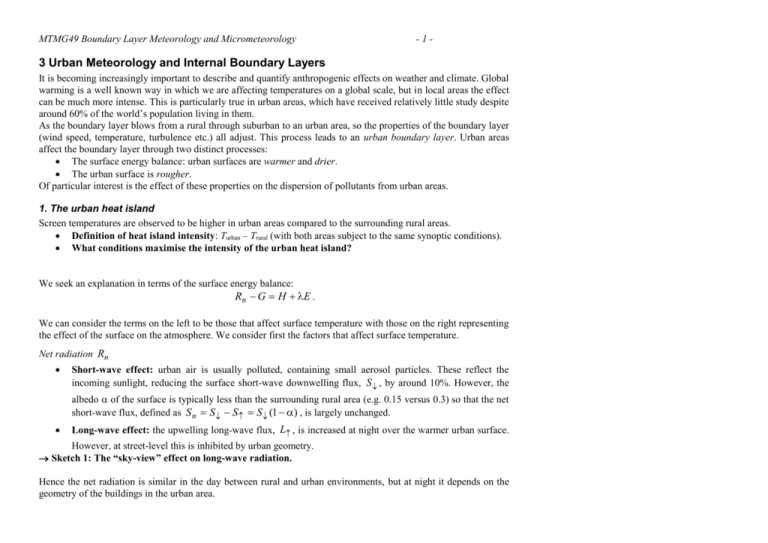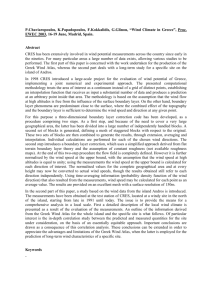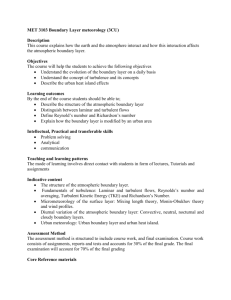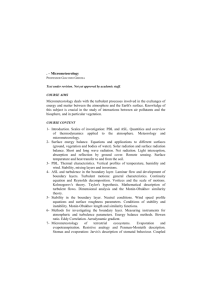3 Urban Meteorology and Internal Boundary Layers
advertisement

MTMG49 Boundary Layer Meteorology and Micrometeorology -1- 3 Urban Meteorology and Internal Boundary Layers It is becoming increasingly important to describe and quantify anthropogenic effects on weather and climate. Global warming is a well known way in which we are affecting temperatures on a global scale, but in local areas the effect can be much more intense. This is particularly true in urban areas, which have received relatively little study despite around 60% of the world’s population living in them. As the boundary layer blows from a rural through suburban to an urban area, so the properties of the boundary layer (wind speed, temperature, turbulence etc.) all adjust. This process leads to an urban boundary layer. Urban areas affect the boundary layer through two distinct processes: The surface energy balance: urban surfaces are warmer and drier. The urban surface is rougher. Of particular interest is the effect of these properties on the dispersion of pollutants from urban areas. 1. The urban heat island Screen temperatures are observed to be higher in urban areas compared to the surrounding rural areas. Definition of heat island intensity: Turban – Trural (with both areas subject to the same synoptic conditions). What conditions maximise the intensity of the urban heat island? We seek an explanation in terms of the surface energy balance: Rn G H E . We can consider the terms on the left to be those that affect surface temperature with those on the right representing the effect of the surface on the atmosphere. We consider first the factors that affect surface temperature. Net radiation Rn Short-wave effect: urban air is usually polluted, containing small aerosol particles. These reflect the incoming sunlight, reducing the surface short-wave downwelling flux, S , by around 10%. However, the albedo of the surface is typically less than the surrounding rural area (e.g. 0.15 versus 0.3) so that the net short-wave flux, defined as S n S S S (1 ) , is largely unchanged. Long-wave effect: the upwelling long-wave flux, L , is increased at night over the warmer urban surface. However, at street-level this is inhibited by urban geometry. Sketch 1: The “sky-view” effect on long-wave radiation. Hence the net radiation is similar in the day between rural and urban environments, but at night it depends on the geometry of the buildings in the urban area. MTMG49 Boundary Layer Meteorology and Micrometeorology -2- Ground heat flux G The urban fabric (buildings and roads) absorbs considerably more heat in the day than rural areas due to the different thermal conductivities and heat capacities and the increased surface area; the sides of buildings are important. In summary, the heat island effect is governed by stored heat in the day liberated at night, and the geometric constraint on outgoing long-wave radiation. Both effects are maximised at night, particularly in the evening, but it is not really known what process dominates and there is little predictive capability for the urban heat island effect. 2. The effect of the urban area on the overlying atmosphere In the surface energy budget equation, H represents the rate at which the surface warms the atmosphere and E is the rate at which it is moistened. Latent heat flux E Depending on the green fraction, this is much reduced compared to rural areas as there is less vegetation and less water available. Sensible heat flux H This must be increased over urban areas to balance the reduction in E , and also because of the warmer surface. In fact, H can stay positive through much of the night due to the surface remaining warmer than the air above. What is the net effect on the boundary layer over urban areas compared to surrounding rural areas? 3. Adjustment to urban roughness Urban areas are limited in horizontal extent so often we need to consider evolution of the flow from a rural area to an urban area. We consider first the effect of the change in surface roughness. We might suspect that the rougher surface promotes more mixing but how exactly does this occur? It takes time for the air to adjust to the change in surface properties so for a full solution we would need to abandon the steady-state solution for the wind profile provided by Monin-Obukhov theory and reintroduce the acceleration terms into the equations of motion. This is very involved but the effect may be simply illustrated by considering a plot of ln(z) versus u for neutral conditions. Sketch 2: Evolution of the wind profile after an increase in roughness length. The consequences of this behaviour are: There is a usually a distinct height hi that marks the top of the internal boundary layer (IBL). Below this the flow is close to equilibrium with the urban surface, while above it the flow is close to equilibrium with the smoother rural surface further away. As a very approximate rule of thumb, the depth of the IBL is related to the distance x since the change in roughness length by hi 0.01x . This distance is referred to as the fetch. MTMG49 Boundary Layer Meteorology and Micrometeorology -3- The friction velocity u* is larger within the IBL, leading to more rapid turbulent mixing of pollution and other parameters. Mixing is particularly strong for short fetches after the increase in roughness length. In Urban Meteorology the IBL associated with an urban surface is referred to as the urban boundary layer. Note that as the air passes from a rougher to a smoother surface, such as from an urban to a rural surface, an IBL is also formed but this time it is associated with a smaller u* and reduced mixing. This is often observed on the Department field site associated with the change in roughness from the trees by the lake to the grass nearer the site. 4. The thermal internal boundary layer At night, when the urban surface is warmest compared to the rural surroundings, a second effect must be considered that also promotes vertical mixing of pollutants. The temperature profile over the rural area will be stable, but as it is advected over the urban region, sensible heat fluxes from the warmer surface will initiate a thermal internal boundary layer (IBL) that is convective in nature. Sketch 3: Growth of the thermal internal boundary layer. It can be seen that the growth of the thermal IBL is very much akin to the growth of the convective boundary layer after sunrise, and indeed we can make a simple modification to Carson’s model (see lecture 2.1) to describe its depth hi . We replace time since sunrise in the original model with time since passing over the new terrain, i.e. a space-time conversion t x / u , where x is the fetch over the new surface. For a constant urban surface sensible heat flux H, the depth is thus given by 21 2 E x hi H , c p u i.e. the depth of the thermal IBL is proportional to x 0.5 . Note that this is valid for an initial profile increasing linearly with height. Such an increase is predicted by Monin-Obukhov theory for stable conditions at heights greater than around a quarter the Obukhov length, but closer to the surface has a more logarithmic increase with height leading to hi being approximately proportional to x, as for the aerodynamic IBL in the previous section. An intense thermal internal boundary layer can occur when stable flow from a cold continent flows out over a warm expanse of water. This is known as a cold air outbreak, and is associated with rapid evaporation from the sea surface and associated moist convection. It has a characteristic signature in satellite imagery because cloud streets are formed parallel to the mean flow, with a spacing that is proportional to the depth of the boundary layer, i.e. increasing with fetch from the coast. In winter in North America this is a serious forecasting issue for the cities around the Great Lakes, because the vigorous moist convection as very cold Canadian air passes over the much warmer lakes then deposits large quantities of snow on the southern shores. This is referred to as lake-effect snow. Further reading: Oke p272-303, Kaimal and Finnigan for flow over different surfaces. Figure 1. Visible satellite image of a cold-air outbreak over the North Atlantic.









